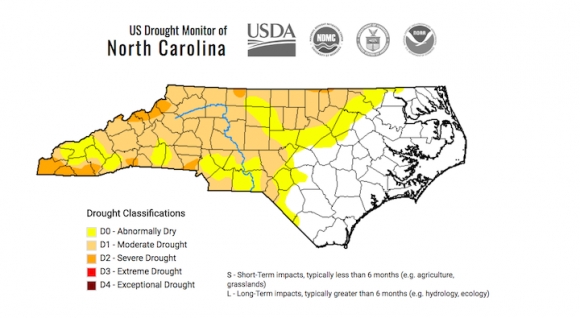Drought worsens in North Carolina

Drought has deepened throughout Central and Western North Carolina, according to a new map published today.
The N.C. Drought Monitor now lists nine counties as experiencing severe drought, the second of the four drought classifications. Affected counties include Clay, Graham, Cherokee, Macon and Jackson. It has been more than two years since severe drought appeared in any part of the state, occurring the week of April 25, 2017.
An additional 48 counties are in moderate drought, the least severe of the four categories. These include Swain and Haywood counties, as well as parts of Graham, Cherokee, Macon, Swain and Jackson counties. Severe drought covers the entirety of Clay County. Twelve counties are listed as abnormally dry, which means they’re not in drought but are drier than typical. Abnormally dry conditions cover parts of Graham, Swain, Macon, Jackson and Haywood counties, including nearly all of Swain, of which only the northwest edge is experiencing actual drought, making it the wettest county in Western North Carolina.
“Another week of little to no rainfall and record high temperatures has led to worsening drought conditions,” said Klaus Albertin, chairman of the N.C. Drought Management Advisory Council. “If the forecast holds, the entire state may experience drought or dry conditions by mid-October.”
September was ranked as the top five hottest on record in most areas, said state climatologist Rebecca Cumbie-Ward. While more seasonal temperatures are slated to return to the state this weekend, the chances of a good rain remain low.
Counties are categorized based on the most severe drought classification to appear in their boundaries. Drought maps are updated every Thursday by the U.S. Drought Monitor in consultation with the N.C. Drought Council. Updated maps are available at www.ncdrought.org.
Water restrictions enacted by local water systems are available at www.ncwater.org/Drought_Monitoring/reporting/displaystate.php.





